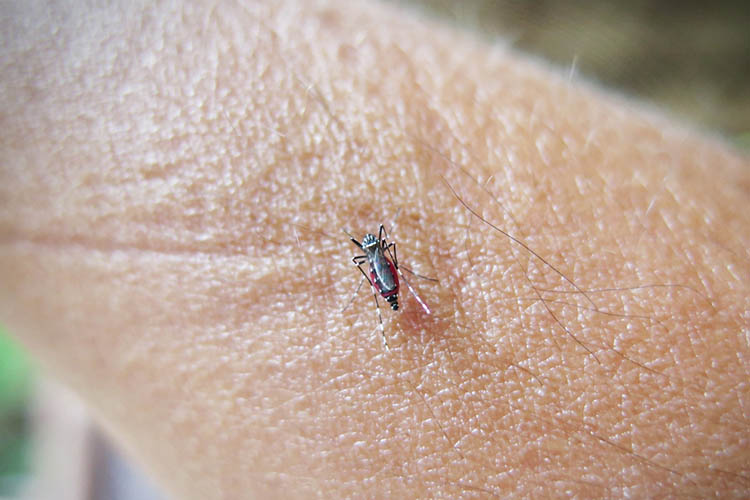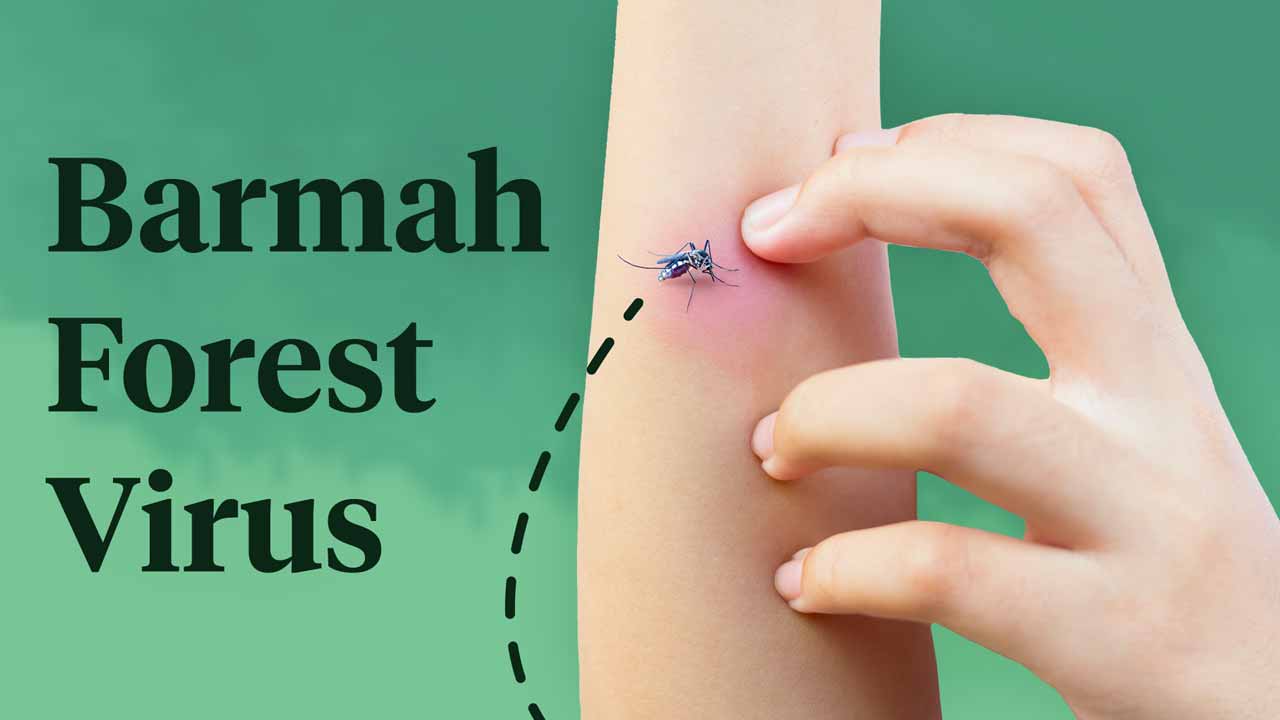Barmah Forest virus (BFV) infection is one of the most common mosquito-borne infections in Australia (along with the Ross River virus infection) (SA Health 2023).
First isolated in the Barmah State Forest near the Murray Valley in 1974, the virus has since been detected in most parts of mainland Australia, with Queensland being the main hotspot. On average, between 1,500 and 2,000 fresh cases are notified each year. Outbreaks are related to higher temperatures, high rainfall and flooding, and are more likely in La Nina years (Health.vic 2020; Griffin n.d.; WA DoH 2020).
Most cases occur in the northern part of Australia between December and February (the wet season). So far, Barmah Forest virus has not been found outside of Australia (Farmer & Suhrbier 2019; Queensland Government 2017).
Spread of Barmah Forest Virus
While BFV was first isolated in Culex annulirostris mosquitoes (common banded mosquito), it has also been found in other species, including Ochlerotatus vigilax (northern salt marsh mosquito), Ochlerotatus camptorhynchus (southern salt marsh mosquito) and Culicoides marksi (Culicoides biting midges). These mosquitoes likely become infected by biting infected marsupials (e.g. possums, kangaroos and wallabies) (Health.vic 2020).

Symptoms of Barmah Forest Virus
Many people infected with BFV do not develop symptoms. In those that do, the incubation period is, on average, between 7 and 10 days (sometimes up to 21 days) (SA Health 2022). Symptoms are similar to those of Ross River virus infection but tend to be milder (Better Health Channel 2022). They may include:
- Flu-like symptoms (fever, chills, headache)
- Fatigue
- Pain, swelling and stiffness in joints (ankles, fingers, knees, wrists)
- Tendon and muscle pain
- Swollen lymph glands
- Rash on the trunk and limbs.
(SA Health 2022; Better Health Channel 2022; NT Health 2023)
Most people completely recover within a few weeks. However, in some cases, it may take up to months or even over a year for the symptoms to resolve. In some of these cases, symptoms are prolonged due to another underlying cause. People who have had BFV are likely to develop life-long immunity (SA Health 2022; Better Health Channel 2022).
Diagnosis of Barmah Forest Virus
Diagnosis is usually by blood tests measuring a rise in IgG antibody over two weeks. A single IgM test may return a false positive result, so a second test should be performed 14 days later (NSW Health 2022).
The disease may need to be distinguished from dengue, Ross River virus infection, infectious mononucleosis, rubella, Q fever, rheumatoid arthritis and systemic lupus erythematosus.
Treatment of Barmah Forest Virus
Treatment is non-specific. Non-steroidal anti-inflammatory medicines, such as ibuprofen, appear to provide the most relief. Paracetamol or aspirin (not in children less than 12 years old) may also be used. Rest and gentle exercise are important to prevent overtiredness and ensure joints are kept moving. Emotional stress and physical fatigue can make the condition worse (SA Health 2022; Queensland Government 2017; NT Health 2023).
Prevention of Barmah Forest Virus
No vaccine is available. However, the condition can be prevented by avoiding mosquito bites (SA Health 2022). This can be achieved by:
- Using insect repellents
- Wearing protective, light-coloured clothing
- Avoiding being outside during times of heavy mosquito infestation (early evenings in warmer months)
- Screening living and sleeping areas
- Checking homes regularly for potential mosquito breeding areas (e.g. uncovered water containers, small wading pools, old tyres).
(Queensland Government 2017)
Particular care should be taken camping or fishing during the mosquito season. Eradication programs are the most effective way to prevent spread. However, wetland mosquitoes can fly up to 20 kilometres from their breeding grounds, potentially making this difficult (Queensland Government 2017; Webb 2019).
Topics
References
- Better Health Channel 2022, Barmah Forest Virus Infection, Victoria State Government, viewed 24 November 2023, https://www.betterhealth.vic.gov.au/health/conditionsandtreatments/barmah-forest-virus-disease
- Farmer, J F & Suhrbier, A 2019, ‘Interpreting Paired Serology for Ross River Virus and Barmah Forest Virus Diseases’, Australian Journal of General Practice, vol. 48, no. 9, viewed 24 November 2023, https://www1.racgp.org.au/ajgp/2019/september/paired-serology-for-ross-river-virus-and-barmah-fo
- Griffin, P 2015, Barmah Forest Virus, Antimicrobe, viewed 24 November 2023, http://www.antimicrobe.org/v25.asp
- Health.vic 2020, Barmah Forest Virus Disease, Victoria State Government, viewed 24 November 2023, https://www.health.vic.gov.au/infectious-diseases/barmah-forest-virus-disease
- NSW Health 2022, Barmah Forest Virus Fact Sheet, New South Wales Government, viewed 24 November 2023, https://www.health.nsw.gov.au/Infectious/factsheets/Pages/barmah_forest_virus_infection.aspx
- NT Health 2023, Barmah Forest Virus, Northern Territory Government, viewed 24 November 2023, https://nt.gov.au/wellbeing/health-conditions-treatments/viral/barmah-forest-virus
- Queensland Government 2017, Barmah Forest Virus, Queensland Government, viewed 24 November 2023, https://www.qld.gov.au/health/condition/infections-and-parasites/viral-infections/barmah-forest-virus
- SA Health 2022, Barmah Forest Virus Infection - Including Symptoms, Treatment and Prevention, Government of South Australia, viewed 24 November 2023, https://www.sahealth.sa.gov.au/wps/wcm/connect/public+content/sa+health+internet/conditions/infectious+diseases/barmah+forest+virus+infection/barmah+forest+virus+infection+-+including+symptoms+treatment+and+prevention
- SA Health 2023, Mosquito-borne Diseases in South Australia, Government of South Australia, viewed 24 November 2023, https://www.sahealth.sa.gov.au/wps/wcm/connect/public+content/sa+health+internet/healthy+living/protecting+your+health/yourself/fight+the+bite/mosquito+borne+disease+explained
- Webb, C 2019, ‘How Far do Mosquitoes Fly, and Why Does it Matter?’, Professional Pest Manager, 1 November, viewed 24 November 2023, https://professionalpestmanager.com/pest-control-mosquitoes/how-far-do-mosquitoes-fly-and-why-does-it-matter/
- Western Australia Department of Health 2020, Medical Entomology Quarterly Report Great Southern Region: Jan – Mar 2020, Government of Western Australia, viewed 24 November 2023, https://ww2.health.wa.gov.au/-/media/Files/Corporate/general-documents/Mosquitoes/PDF/Mosquito-borne-disease-data/Jan-Mar-2020/Medical-Entomology-Quarterly-Report-Great-Southern-Jan-to-Mar-2020.pdf

